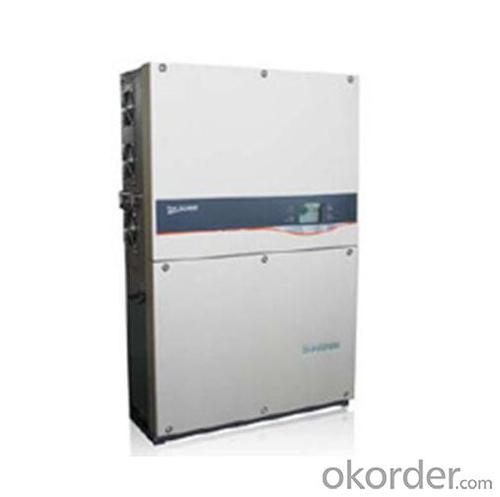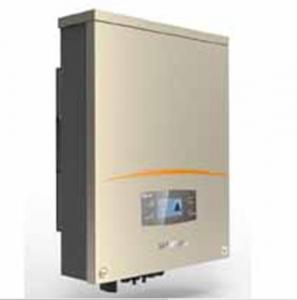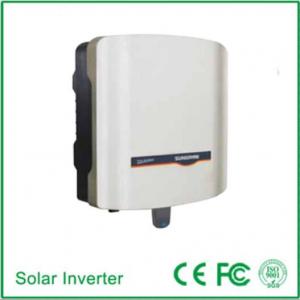Solar Photovoltaic Grid-Connected Inverter SG60KTL
- Loading Port:
- China Main Port
- Payment Terms:
- TT or LC
- Min Order Qty:
- 50000 unit
- Supply Capability:
- 3000000 unit/month
OKorder Service Pledge
OKorder Financial Service
You Might Also Like
1. Structure of Solar Photovoltaic Grid-Connected Inverter SG60KTL Description
Suitable for 50Hz/60Hz grid, could be used in Asia, Africa and Europe. Available for hand installation, no need for lifting machinery assistance.
IP65;Integrated DC combine and surge protection function
TUV,CE,G59/3,BDEW,CGC,GB-T19964
2. Main Features of the Solar Photovoltaic Grid-Connected Inverter SG60KTL
Flexible
• Handy and light, easy to handle without lift machinery assistance, lower the cost of installation and maintenance.
• Integrated DC combine and surge protection function, lower the system cost
• DC arc detection function(optional), further enhance the safety performance
Efficient
• Max. Efficiency at 99%
• Integrated string detection function, find mismatch panel in time and accurately
• Integrated PV panel PID effect eliminate function( optional), decrease the loss of generation attenuation.
Grid-friendly
• Fullfil a variety of reactive power adjustment requirments with power factor 0.8overexited ~0.8 underexited
• Active power continuously adjustable (0~100%)
• Integrated LVRT , HVRT and night SVG function
Qualified
• TÜV, CE, G59/3, BDEW, CGC and GB-T19964 certification.
3. Solar Photovoltaic Grid-Connected Inverter SG60KTL Images
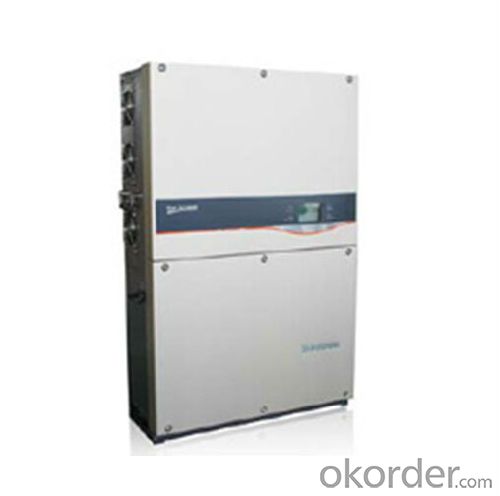
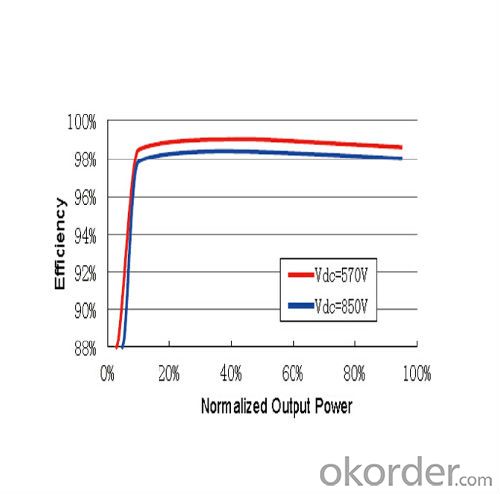

4. Solar Photovoltaic Grid-Connected Inverter SG60KTL Specification
Grid Type | 230V/400Vac |
Input Side Data | |
Max. PV input power | 67500W |
Max. PV input voltage | 1000V |
Startup voltage | 620V |
MPP voltage range | 570~950V |
MPP voltage range for nominal power | 570~850V |
No. of MPPTs | 1 |
Max. number of PV strings per MPPT | 12 |
Max. PV input current | 120 |
Max. current for input connector | 12A |
Output Side Data | |
Nominal AC output power | 60000W |
Max AC output power(PF=1) | 66000W |
Max. AC output apparent power | 66000VA |
Max. AC output current | 96A |
Nominal AC voltage | 3P+N+PE/3P+PE, 230/400Vac |
AC voltage range | 310~480Vac |
Nominal grid frequency | 50Hz/60Hz |
Grid frequency range | 45~55Hz/55~ 65Hz |
THD | < 3 % (Nominal power) |
DC current injection | <0.5 %In |
Power factor | >0.99@default value at nominal power,(adj. 0.8overexcited ~0.8underexited) |
Protection | |
Anti-islanding protection | Yes |
LVRT | Yes |
DC reverse connection protection | Yes |
AC short circuit protection | Yes |
Leakage current protection | Yes |
DC switch | Yes |
AC switch | Optional |
DC fuse | Yes |
PV String detection | Optional |
ARC detection | Optional |
DC Overvoltage protection | DC Type II DIN rail surge |
AC Overvoltage protection | Optional AC Type II DIN |
System Data | |
Max. efficiency | 99.00% |
Max. European efficiency | 98.70% |
Isolation method | Transformerless |
Ingress protection rating | IP65 |
Night power consumption | <1W |
Operating ambient temperature range | -25~60℃(>50℃ derating) |
Allowable relative humidity range | 0~100% |
Cooling method | Smart forced air cooling |
Max. operating altitude | 4000m (>3000m derating) |
Display | Graphic LCD |
Communication | RS485 |
DC connection type | MC4/Screw Clamp terminal |
AC connection type | Screw Clamp terminal |
Certification | VDE0126-1-1,EN62109-1,EN62109-2,G59/3, |
Mechanical Data | |
Dimensions(W×H×D) | 634×959×267mm |
Mounting method | Wall bracket |
Weight | 55kg |
*Specifications subject to change without notice.
5. FAQ of Solar Photovoltaic Grid-Connected Inverter SG60KTL
Q1. What is the difference between inverter and solar inverter?
A1. Inverter only has AC inpput, but solar inverter both connect to AC input and solar panel, it saves more power.
Q2. What is the difference between MPPT&PWM?
A2. MPPT has higher efficiency, it can track the max power point and won't waste energy.
- Q: Can a solar inverter be used with different types of backup power configurations?
- Yes, a solar inverter can be used with different types of backup power configurations. Solar inverters are designed to convert the DC power generated by solar panels into AC power that can be used to power electrical devices and appliances. They can be integrated with various backup power systems such as batteries, generators, or grid connections to provide uninterrupted power supply during periods of low solar generation or power outages. The versatility of solar inverters allows for flexibility in choosing and combining backup power sources based on specific needs and preferences.
- Q: Can a solar inverter be used with a solar-powered greenhouse system?
- Yes, a solar inverter can be used with a solar-powered greenhouse system. A solar inverter is necessary to convert the direct current (DC) electricity generated by the solar panels into alternating current (AC) electricity that can be used to power the various components of a greenhouse system, such as fans, lighting, and irrigation systems.
- Q: Can a solar inverter be used with different tracking algorithms?
- Yes, a solar inverter can be used with different tracking algorithms. Solar inverters are designed to convert the direct current (DC) produced by solar panels into alternating current (AC) that can be used to power electrical devices. The tracking algorithm is responsible for optimizing the solar panel's position to maximize energy generation. Different tracking algorithms, such as fixed tilt, single-axis, or dual-axis tracking, can be implemented with a solar inverter to adapt to different solar panel orientations and environmental conditions.
- Q: How do you connect a solar inverter to the electrical grid?
- To connect a solar inverter to the electrical grid, you typically follow a few steps. First, ensure that your solar panels are properly installed and generating electricity. Then, connect the DC output of the solar panels to the DC input of the inverter. Next, connect the AC output of the inverter to your home's electrical distribution panel or directly to the electrical grid through a utility meter. Finally, consult with a qualified electrician to ensure that the installation meets all relevant safety and electrical codes.
- Q: Do I need a special inverter for a battery storage system?
- Yes, a special inverter is needed for a battery storage system. Unlike a regular inverter that converts DC power from solar panels into AC power for immediate use, a battery storage system requires an inverter that can not only convert DC power to AC power but also manage the charging and discharging of the batteries efficiently. This special inverter is designed to work seamlessly with the battery storage system, ensuring optimal performance and maximizing the utilization of stored energy.
- Q: What is the role of a galvanic isolation circuit in a solar inverter?
- The role of a galvanic isolation circuit in a solar inverter is to provide electrical safety by preventing the flow of direct current (DC) between the solar panels and the alternating current (AC) grid. It isolates the input and output sides of the inverter, protecting the user and the equipment from potential hazards such as electrical shocks and short circuits. Additionally, it helps in reducing noise and improving the overall performance and efficiency of the solar inverter system.
- Q: Can a solar inverter be used in commercial applications?
- Yes, a solar inverter can be used in commercial applications. Solar inverters are designed to convert the direct current (DC) generated by solar panels into alternating current (AC) that can be used to power electrical devices and appliances. This makes them suitable for a wide range of commercial applications such as offices, retail stores, factories, and other commercial buildings where solar energy can be harnessed to reduce electricity costs and promote sustainability.
- Q: How is a solar inverter different from a regular inverter?
- A solar inverter converts the direct current (DC) generated by solar panels into alternating current (AC) to be used in homes or fed back into the electric grid. In contrast, a regular inverter is typically used to convert DC power from batteries or other sources into AC power for general electrical use. The main difference lies in their purpose and the source of the DC power they convert.
- Q: How do you maintain a solar inverter?
- To maintain a solar inverter, regular cleaning of dust and debris is essential to ensure efficient operation. Additionally, monitoring the inverter's performance and checking for any abnormal readings or error messages is important. It is also recommended to inspect the wiring connections for any loose or damaged parts and to keep the inverter's ventilation system clear from obstructions. Regular servicing by a professional technician is recommended to identify and address any potential issues before they become major problems.
- Q: Can a solar inverter be used in areas with unstable grid power?
- Yes, a solar inverter can be used in areas with unstable grid power. Solar inverters are designed to convert the DC power generated by solar panels into AC power for use in homes or businesses. In areas with unstable grid power, a solar inverter can help stabilize the electricity supply by utilizing the solar energy generated. It can operate independently or in conjunction with the grid, providing a reliable power source even during grid outages or fluctuations.
Send your message to us
Solar Photovoltaic Grid-Connected Inverter SG60KTL
- Loading Port:
- China Main Port
- Payment Terms:
- TT or LC
- Min Order Qty:
- 50000 unit
- Supply Capability:
- 3000000 unit/month
OKorder Service Pledge
OKorder Financial Service
Similar products
Hot products
Hot Searches
Related keywords


